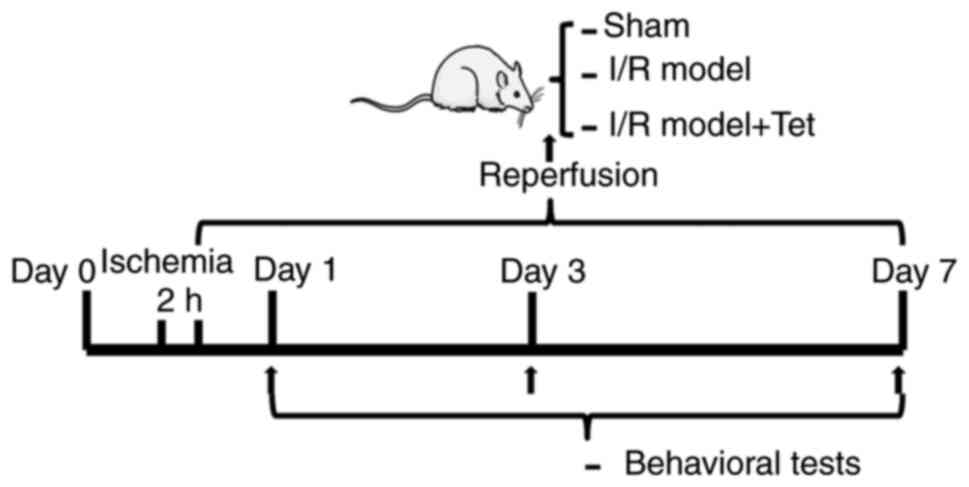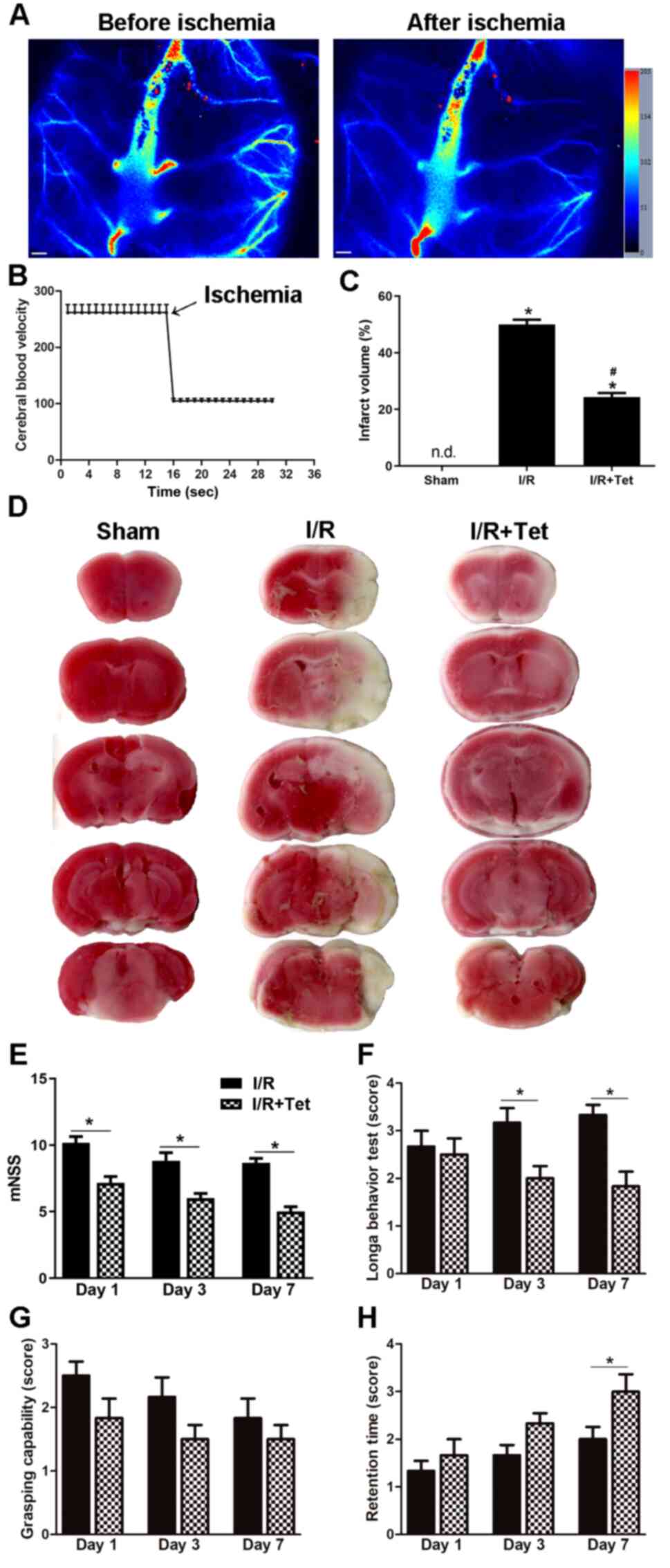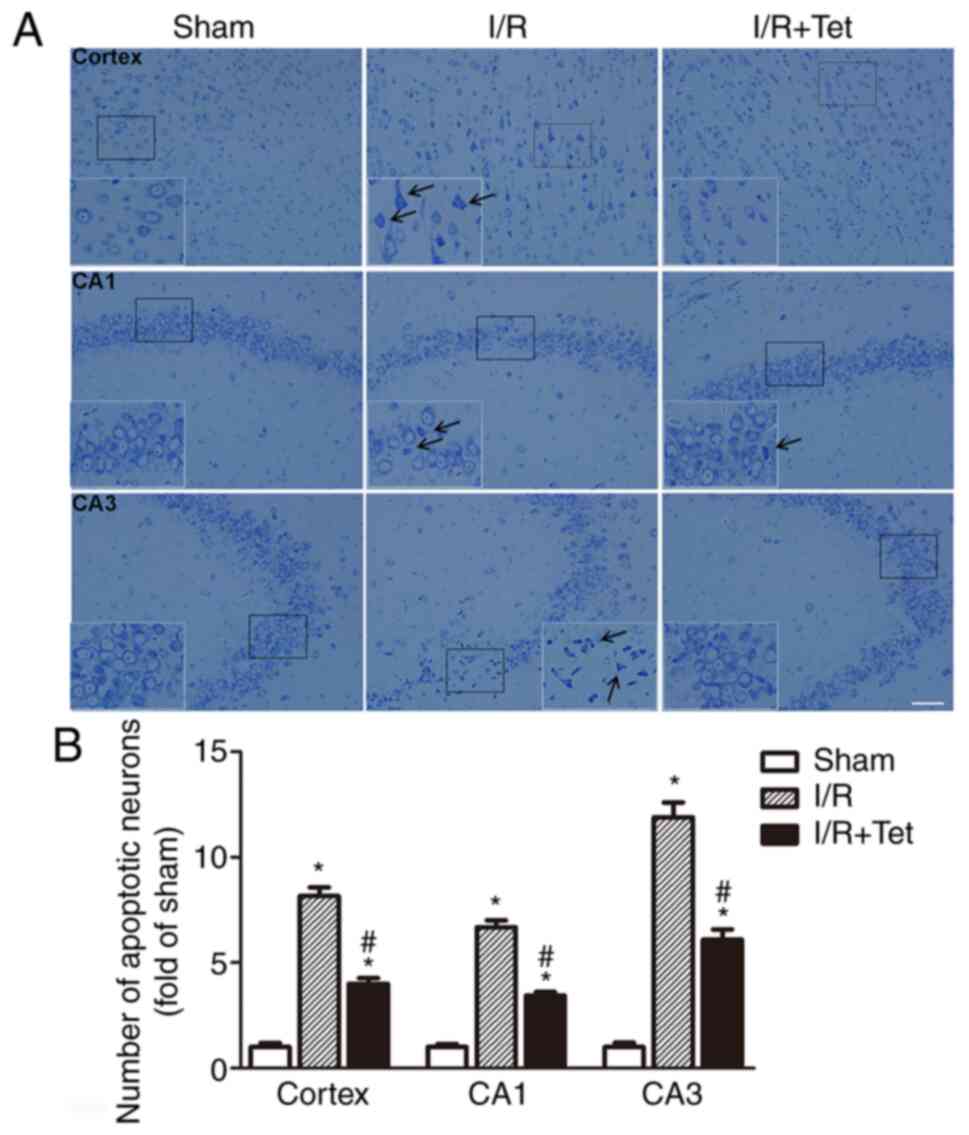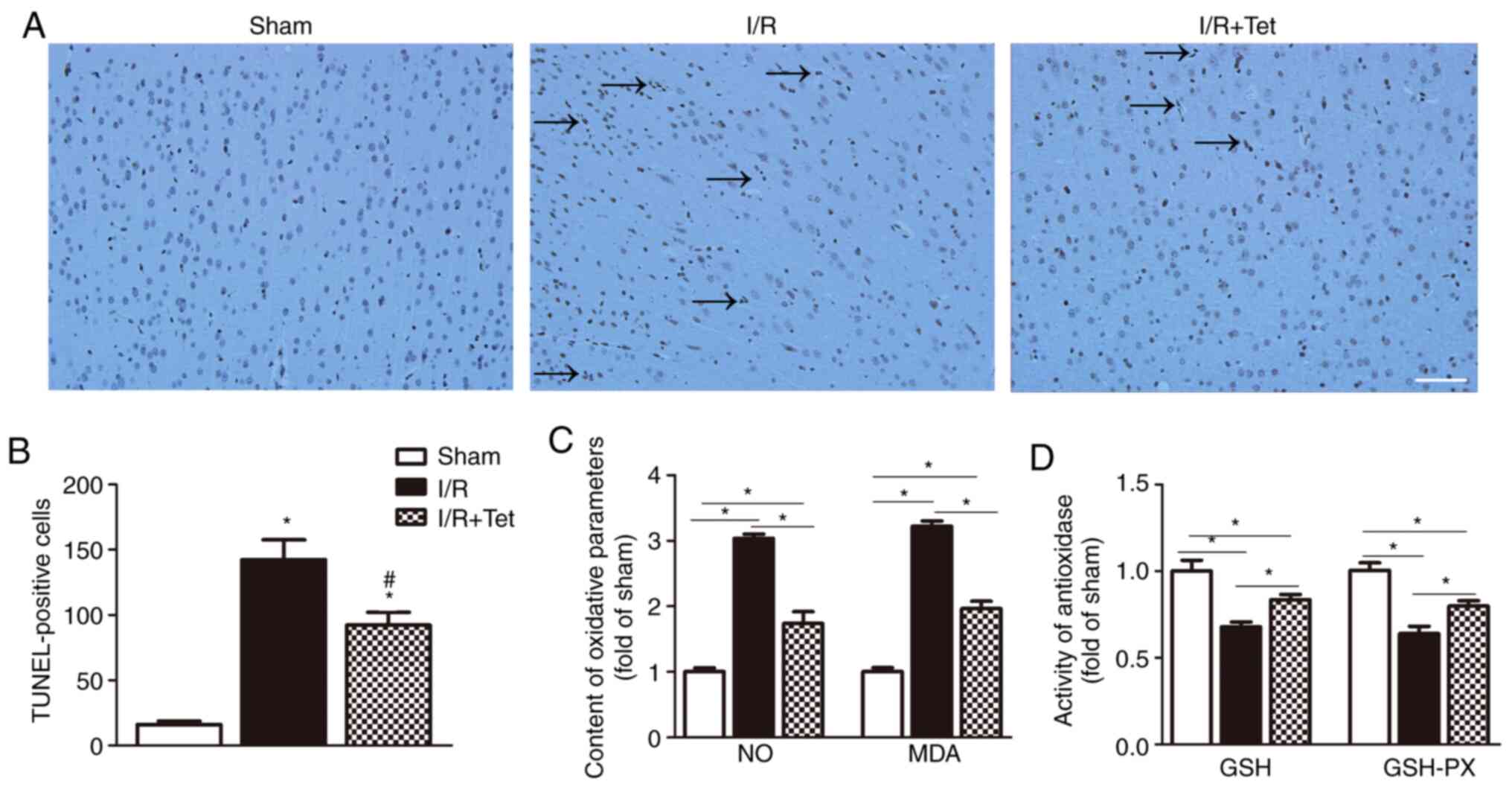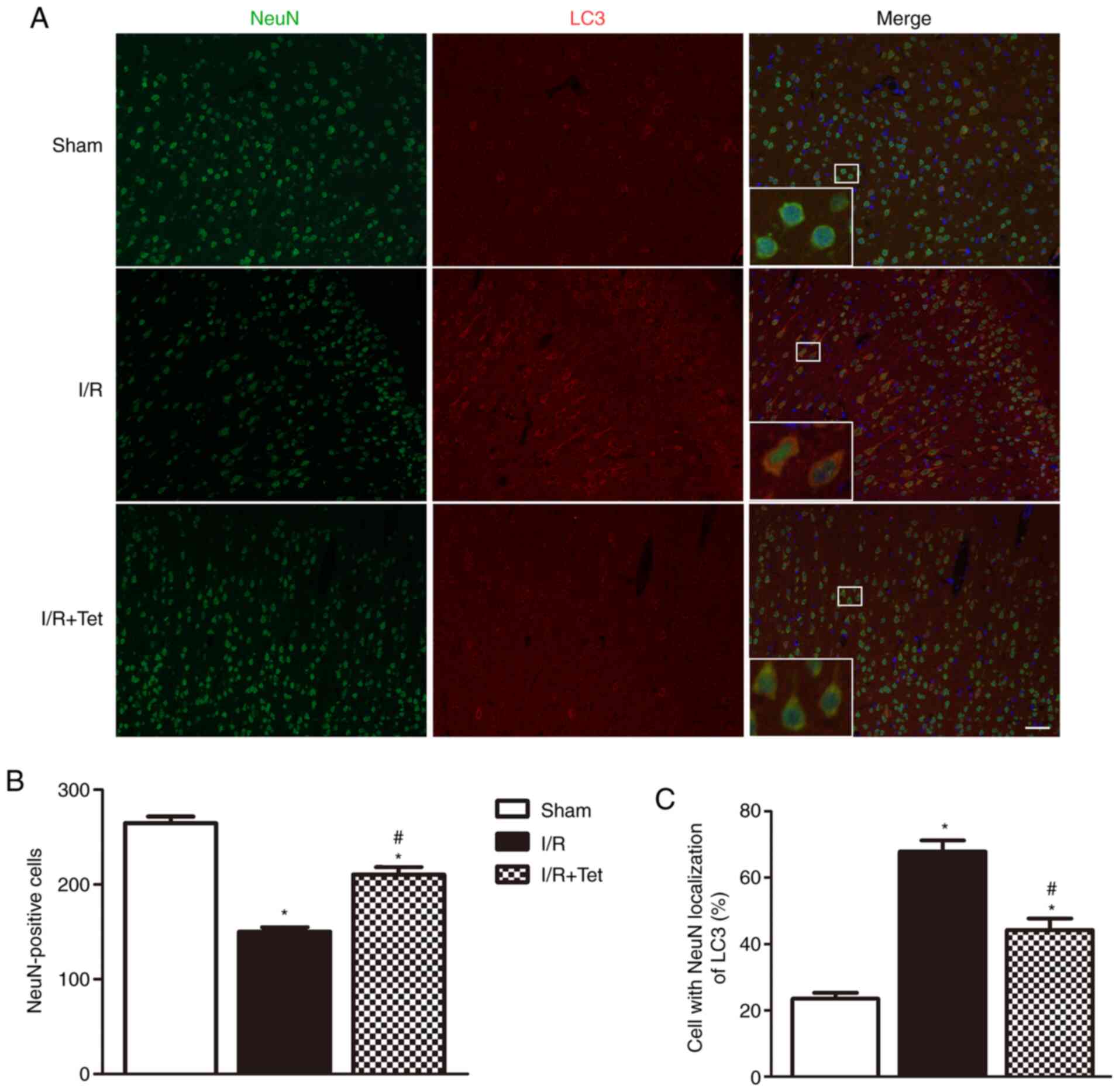|
1
|
World Health Organization, . Global Health
Estimates 2016: Disease Burden by Cause, Age, Sex, by Country and
by Region, 2000–2016. World Health Organization; Geneva: 2018
|
|
2
|
Naderi Y, Panahi Y, Barreto GE and
Sahebkar A: Neuroprotective effects of minocycline on focal
cerebral ischemia injury: A systematic review. Neural Regen Res.
15:773–782. 2020. View Article : Google Scholar : PubMed/NCBI
|
|
3
|
Moussaddy A, Demchuk AM and Hill MD:
Thrombolytic therapies for ischemic stroke: Triumphs and future
challenges. Neuropharmacology. 134:272–279. 2018. View Article : Google Scholar : PubMed/NCBI
|
|
4
|
Broome LJ, Battle CE, Lawrence M, Evans PA
and Dennis MS: Cognitive outcomes following thrombolysis in acute
ischemic stroke: A systematic review. J Stroke Cerebrovasc Dis.
25:2868–2875. 2016. View Article : Google Scholar : PubMed/NCBI
|
|
5
|
Tang YN, Zhang GF, Chen HL, Sun XP, Qin
WW, Shi F, Sun LX, Xu XN and Wang MS: Selective brain
hypothermia-induced neuroprotection against focal cerebral
ischemia/reperfusion injury is associated with Fis1 inhibition.
Neural Regen Res. 15:903–911. 2020. View Article : Google Scholar : PubMed/NCBI
|
|
6
|
Kalogeris T, Baines CP, Krenz M and
Korthuis RJ: Ischemia/reperfusion. Compr Physiol. 7:113–170. 2016.
View Article : Google Scholar : PubMed/NCBI
|
|
7
|
Woodruff TM, Thundyil J, Tang SC, Sobey
CG, Taylor SM and Arumugam TV: Pathophysiology, treatment, and
animal and cellular models of human ischemic stroke. Mol
Neurodegener. 6:112011. View Article : Google Scholar : PubMed/NCBI
|
|
8
|
Broughton BR, Reutens DC and Sobey CG:
Apoptotic mechanisms after cerebral ischemia. Stroke. 40:e331–e339.
2009. View Article : Google Scholar : PubMed/NCBI
|
|
9
|
Niizuma K, Yoshioka H, Chen H, Kim GS,
Jung JE, Katsu M, Okami N and Chan PH: Mitochondrial and apoptotic
neuronal death signaling pathways in cerebral ischemia. Biochim
Biophys Acta. 1802:92–99. 2010. View Article : Google Scholar : PubMed/NCBI
|
|
10
|
Li W and Yang S: Targeting oxidative
stress for the treatment of ischemic stroke: Upstream and
downstream therapeutic strategies. Brain Circ. 2:153–163. 2016.
View Article : Google Scholar : PubMed/NCBI
|
|
11
|
Suh SW, Shin BS, Ma HL, Van Hoecke M,
Brennan AM, Yenari MA and Swanson RA: Glucose and NADPH oxidase
drive neuronal superoxide formation in stroke. Ann Neurol.
64:654–663. 2008. View Article : Google Scholar : PubMed/NCBI
|
|
12
|
Allen CL and Bayraktutan U: Oxidative
stress and its role in the pathogenesis of ischaemic stroke. Int J
Stroke. 4:461–470. 2009. View Article : Google Scholar : PubMed/NCBI
|
|
13
|
Zheng YQ, Liu JX, Wang JN and Xu L:
Effects of crocin on reperfusion-induced oxidative/nitrative injury
to cerebral microvessels after global cerebral ischemia. Brain Res.
1138:86–94. 2007. View Article : Google Scholar : PubMed/NCBI
|
|
14
|
Li W, Yang Y, Hu Z, Ling S and Fang M:
Neuroprotective effects of DAHP and triptolide in focal cerebral
ischemia via apoptosis inhibition and PI3K/Akt/mTOR pathway
activation. Front Neuroanat. 9:482015. View Article : Google Scholar : PubMed/NCBI
|
|
15
|
Yang G, Wang N, Seto SW, Chang D and Liang
H: Hydroxysafflor yellow a protects brain microvascular endothelial
cells against oxygen glucose deprivation/reoxygenation injury:
Involvement of inhibiting autophagy via class I PI3K/Akt/mTOR
signaling pathway. Brain Res Bull. 140:243–257. 2018. View Article : Google Scholar : PubMed/NCBI
|
|
16
|
Carbone F, Teixeira PC, Braunersreuther V,
Mach F, Vuilleumier N and Montecucco F: Pathophysiology and
treatments of oxidative injury in ischemic stroke: Focus on the
phagocytic NADPH oxidase 2. Antioxid Redox Signal. 23:460–489.
2015. View Article : Google Scholar : PubMed/NCBI
|
|
17
|
Ho LJ, Chang DM, Chang ML, Kuo SY and Lai
JH: Mechanism of immunosuppression of the antirheumatic herb TWHf
in human T cells. J Rheumatol. 26:14–24. 1999.PubMed/NCBI
|
|
18
|
Chen Y and Tseng SH: The potential of
tetrandrine against gliomas. Anticancer Agents Med Chem.
10:534–542. 2010. View Article : Google Scholar : PubMed/NCBI
|
|
19
|
Liu Z, Xu Z, Shen W, Li Y, Zhang J and Ye
X: Effect of pharmacologic preconditioning with tetrandrine on
subsequent ischemia/reperfusion injury in rat liver. World J Surg.
28:620–624. 2004. View Article : Google Scholar : PubMed/NCBI
|
|
20
|
Shen YC, Chen CF and Sung YJ: Tetrandrine
ameliorates ischaemia-reperfusion injury of rat myocardium through
inhibition of neutrophil priming and activation. Br J Pharmacol.
128:1593–1601. 1999. View Article : Google Scholar : PubMed/NCBI
|
|
21
|
Wong TM, Wu S, Yu XC and Li HY:
Cardiovascular actions of radix Stephaniae tetrandrae: A
comparison with its main component, tetrandrine. Acta Pharmacol
Sin. 21:1083–1088. 2000.PubMed/NCBI
|
|
22
|
Chen Y1, Wu JM, Lin TY, Wu CC, Chiu KM,
Chang BF, Tseng SH and Chu SH: Tetrandrine ameliorated reperfusion
injury of small bowel transplantation. J Pediatr Surg.
44:2145–2152. 2009. View Article : Google Scholar : PubMed/NCBI
|
|
23
|
Yang S, Wang H, Yang Y, Wang R, Wang Y, Wu
C and Du G: Baicalein administered in the subacute phase
ameliorates ischemia-reperfusion-induced brain injury by reducing
neuroinflammation and neuronal damage. Biomed Pharmacother.
117:1091022019. View Article : Google Scholar : PubMed/NCBI
|
|
24
|
Laschke MW, Vollmar B and Menger MD: The
dorsal skinfold chamber: Window into the dynamic interaction of
biomaterials with their surrounding host tissue. Eur Cells Mater.
22:147–167. 2011. View Article : Google Scholar
|
|
25
|
Deng Y, Xiong D, Yin C, Liu B, Shi J and
Gong Q: Icariside II protects against cerebral ischemia-reperfusion
injury in rats via nuclear factor-κB inhibition and peroxisome
proliferator-activated receptor up-regulation. Neurochem Int.
96:56–61. 2016. View Article : Google Scholar : PubMed/NCBI
|
|
26
|
Wang PR, Wang JS, Zhang C, Song XF, Tian N
and Kong LY: Huang-Lian-Jie-Du-decotion induced protective
autophagy against the injury of cerebral ischemia/reperfusion via
MAPK-mTOR signaling pathway. J Ethnopharmacol. 149:270–280. 2013.
View Article : Google Scholar : PubMed/NCBI
|
|
27
|
He H, Liu W, Zhou Y, Liu Y, Weng P, Li Y
and Fu H: Sevoflurane post-conditioning attenuates traumatic brain
injury-induced neuronal apoptosis by promoting autophagy via the
PI3K/AKT signaling pathway. Drug Des Devel Ther. 12:629–638. 2018.
View Article : Google Scholar : PubMed/NCBI
|
|
28
|
Iadecola C and Anrather J: The immunology
of stroke: From mechanisms to translation. Nat Med. 17:796–808.
2011. View
Article : Google Scholar : PubMed/NCBI
|
|
29
|
He BC, Gao JL, Zhang BQ, Luo Q, Shi Q, Kim
SH, Huang E, Gao Y, Yang K, Wagner ER, et al: Tetrandrine inhibits
Wnt/β-catenin signaling and suppresses tumor growth of human
colorectal cancer. Mol Pharmacol. 79:211–219. 2011. View Article : Google Scholar : PubMed/NCBI
|
|
30
|
Bhagya N and Chandrashekar KR:
Tetrandrine-A molecule of wide bioactivity. Phytochemistry.
125:5–13. 2016. View Article : Google Scholar : PubMed/NCBI
|
|
31
|
Chen Y, Tsai YH and Tseng SH: The
potential of tetrandrine as a protective agent for ischemic stroke.
Molecules. 16:8020–8032. 2011. View Article : Google Scholar : PubMed/NCBI
|
|
32
|
Ruan L, Huang HS, Jin WX, Chen HM, Li XJ
and Gong QJ: Tetrandrine attenuated cerebral ischemia/reperfusion
injury and induced differential proteomic changes in a MCAO mice
model using 2-D DIGE. Neurochem Res. 38:1871–1879. 2013. View Article : Google Scholar : PubMed/NCBI
|
|
33
|
De Silva TM and Miller AA: Cerebral small
vessel disease: Targeting oxidative stress as a novel therapeutic
strategy? Front Pharmacol. 7:612016. View Article : Google Scholar : PubMed/NCBI
|
|
34
|
Grochowski C, Litak J, Kamieniak P and
Maciejewski R: Oxidative stress in cerebral small vessel disease.
Role of reactive species. Free Radic Res. 52:1–13. 2018. View Article : Google Scholar : PubMed/NCBI
|
|
35
|
Yang Q, Huang Q, Hu Z and Tang X:
Potential neuroprotective treatment of stroke: Targeting
excitotoxicity, oxidative stress, and inflammation. Front Neurosci.
13:10362019. View Article : Google Scholar : PubMed/NCBI
|
|
36
|
Wu MY, Yiang GT, Liao WT, Tsai AP, Cheng
YL, Cheng PW, Li CY and Li CJ: Current mechanistic concepts in
ischemia and reperfusion injury. Cell Physiol Biochem.
46:1650–1667. 2018. View Article : Google Scholar : PubMed/NCBI
|
|
37
|
Jaeschke H and Woolbright BL: Current
strategies to minimize hepatic ischemia-reperfusion injury by
targeting reactive oxygen species. Transplant Rev (Orlando).
26:103–114. 2012. View Article : Google Scholar : PubMed/NCBI
|
|
38
|
Koh SB, Ban JY, Lee BY and Seong YH:
Protective effects of fangchinoline and tetrandrine on hydrogen
peroxide-induced oxidative neuronal cell damage in cultured rat
cerebellar granule cells. Planta Med. 69:506–512. 2003. View Article : Google Scholar : PubMed/NCBI
|
|
39
|
Xu M and Zhang HL: Death and survival of
neuronal and astrocytic cells in ischemic brain injury: A role of
autophagy. Acta Pharmacol Sin. 32:1089–1099. 2011. View Article : Google Scholar : PubMed/NCBI
|
|
40
|
Wang JF, Mei ZG, Fu Y, Yang SB, Zhang SZ,
Huang WF, Xiong L, Zhou HJ, Tao W and Feng ZT: Puerarin protects
rat brain against ischemia/reperfusion injury by suppressing
autophagy via the AMPK-mTOR-ULK1 signaling pathway. Neural Regen
Res. 13:989–998. 2018. View Article : Google Scholar : PubMed/NCBI
|
|
41
|
Huang YG, Tao W, Yang SB, Wang JF, Mei ZG
and Feng ZT: Autophagy: Novel insights into therapeutic target of
electroacupuncture against cerebral ischemia/reperfusion injury.
Neural Regen Res. 14:954–961. 2019. View Article : Google Scholar : PubMed/NCBI
|
|
42
|
Mo Y, Sun YY and Liu KY: Autophagy and
inflammation in ischemic stroke. Neural Regen Res. 15:1388–1396.
2020. View Article : Google Scholar : PubMed/NCBI
|
|
43
|
Jiang WW, Huang BS, Han Y, Deng LH and Wu
LX: Sodium hydrosulfide attenuates cerebral ischemia/reperfusion
injury by suppressing overactivated autophagy in rats. FEBS Open
Bio. 7:1686–1695. 2017. View Article : Google Scholar : PubMed/NCBI
|
|
44
|
Liu T, Liu X and Li W: Tetrandrine, a
Chinese plant-derived alkaloid, is a potential candidate for cancer
chemotherapy. Oncotarget. 7:40800–40815. 2016. View Article : Google Scholar : PubMed/NCBI
|
|
45
|
Liu T, Men Q, Wu G, Yu C, Huang Z, Liu X
and Li W: Tetrandrine induces autophagy and differentiation by
activating ROS and Notch1 signaling in leukemia cells. Oncotarget.
6:7992–8006. 2015. View Article : Google Scholar : PubMed/NCBI
|















